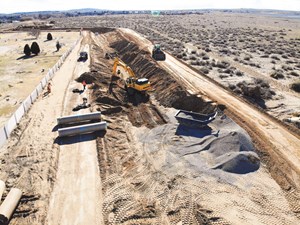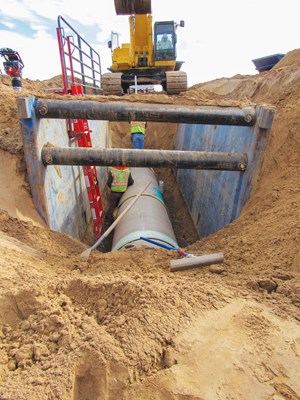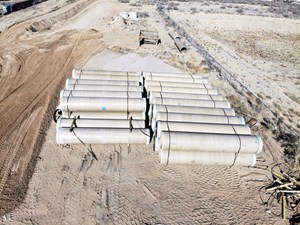April 2020 Vol. 75 No. 4
Features
Project Lowers Flooding Risk in Albuquerque’s South Valley
By Kimberly Paggioli
For more than three centuries, the verdant South Valley of Albuquerque has been a bountiful farming community with irrigation ditches leading to and from the iconic Rio Grande River. While these ditches are the lifeline to the farming and ranching residents of the area, they can be dangerous. According to the Albuquerque Metropolitan Arroyo Flood Control Authority (AMAFCA), some ditches have deadly undertows, and many contain rocks, glass, barbed wire and even dead animals.
The months of March through October can be especially perilous, because the ditches are usually filled with water. Undertows can happen at any time of the year. In spring the water is cold enough to cause shock and hypothermia. These ditches can be prone to overflowing and rushing water due to rain or melted snow roaring down from the mountains and causing flash floods, or sudden downpours during the state’s monsoon season. Flooded ditches can lead to drowning – New Mexico’s number-one natural disaster – within minutes.
It then came as no surprise that, over time, a practical solution was needed to keep water in the South Valley running safely and smoothly.
“There was a lot of flooding in the valley floor because of limited outlets from the inside of levees into the Rio Grande,” said AMAFCA Development Review Engineer Nicole Friedt, P.E. “The dams were being used to drain irrigation facilities, and that’s not their purpose. We needed to provide appropriate outlets.”
In its quest to create a solution to the irrigation and storm drainage issues, AMAFCA enlisted the expertise of local engineering and architectural firm Wilson & Company.
“If there is a huge storm and the irrigation ditches are full of stormwater, the water can’t get out of the dam,” said the company’s Design Engineer Tyler Ashton, P.E., PMP, CFM. “Back-to-back storms could cause a big problem.”
To devise a design solution, engineers searched for an easy and inexpensive alternative for project placement. “We reviewed three main corridors and chose the one with the least amount of existing utilities,” Ashton said.
“If we ran a pipe down a road to the east, we would have had 202 conflicts. Another road had 69 conflicts. The most economical corridor was the Gun Club Lateral because it only presented 19 conflicts in the three-mile stretch. Its terrain is super flat. Fortunately, the site is also raised, which allows gravity to create positive flow.”
Phases
The first phase of the Black Mesa Project was constructed in 2009 by the U.S. Army Corps of Engineers, with a cost shared by Bernalillo County and AMAFCA. AMAFCA constructed the next phases: I-A in 2014 and Phase II in early 2019. Estimated to cost $7.6 million, construction of Phase III and Phase IV began in November 2019 and was projected to finish by March 2020.
When completed, the project will connect the drainage from three dams – Don Felipe Dam, Raymac Dam and McCoy Dam – into one pipe manifold and drain the water to the Rio Grande River.
“Three individual dams and three separate pipes would have been very expensive,” said AMAFCA Executive Engineer Jerry Lovato, P.E. “By minimizing how much pipe we put into the ground, this project will save money. Once the dams are connected, the pipe is pressurized.”
When selecting materials, AMAFCA chose Hobas Pipe USA centrifugally cast, glass-fiber-reinforced, polymer mortar,
42-inch and 36-inch pipes with tee bases and 30-inch flanged tops to serve as irrigation piping for agriculture.
One of the main reasons for using Hobas pipe is its pressure rating. “Normally we would use reinforced concrete pipe, but it doesn’t have the required 21.6 PSI pressure rating,” Lovato explained. “Even though that may be considered a low-pressure rating for Hobas, it’s high for us.”
The construction timetable is critical. “AMAFCA shares the right-of-way with the Middle Rio Grande Conservancy District, which supplies irrigation water through open ditches to farmers,” he said.
“Construction can only take place in a four-month time window between Nov. 1 and March 1, when it’s not irrigation season. After November 1, we can close down the ditches, dig the holes, put pipe in the ground, cover the pipe, test the pipe, and put the ditches back together. It’s important that irrigation is flowing by March 1.”
“Hobas fittings and flanges are specially fabricated,” said AMAFCA’s Friedt. “All of the fittings are fiberglass bends with an angle bend in 37-foot sections,” using 20-foot complete lengths of pipe.
Construction window
Working in the winter months and in extremely limited working space can make construction a challenge. Albuquerque-based contractor AUI Inc. has met these challenges head-on, without any setback.
AUI Project Manager Marshall Vickers pointed out that “the pipe is very durable and used for a variety of applications. We’re using this pipe in a storm drain application, which is installed underneath the existing irrigation canal.”
“Because work is performed in a ditch right-of-way, the actual working area ranges from 50 to 80 feet, which includes the ditch bank,” Friedt noted. “The excavation depth is usually 10 to 25 feet.”
In addition, the three dams currently have gates. “We have to keep the gates closed and only open them when water can be discharged into the Conservancy district,” Lovato added. “That takes time. After the project is over, the gates will be removed. Whenever it rains, the dams
will be able to produce outflow, which is much better for public safety.”
When Phase V is completed in early 2021, it will bring the total feet of pipe used for the Black Mesa Project to more than five miles. •
FOR MORE INFORMATION:
AUI Inc., (505) 242-4848, auiinc.net
Hobas Pipe USA, (800) 856-7473, (281) 821-2200, hobaspipe.com







Comments